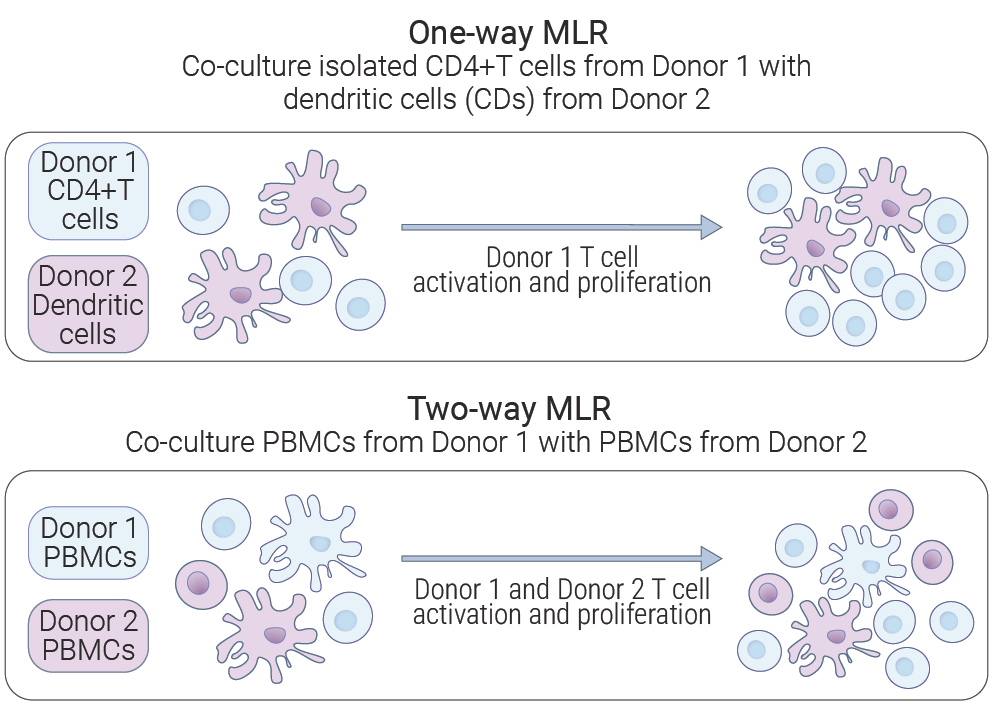Mixed Lymphocyte Reaction (MLR) assays are a crucial in vitro experimental method used to study the interactions and responses of immune cells. This assay is particularly important in fields such as transplantation immunology, immune regulation research, and immunotherapy development.
The primary purpose of MLR assays is to evaluate the immune response that occurs when lymphocytes from different genetic backgrounds are mixed. This is typically done with allogeneic lymphocytes (from different individuals of the same species) or xenogeneic lymphocytes (from different species). The MLR assay is instrumental in assessing how T cells react to foreign antigens presented by dendritic cells (DCs) or other antigen-presenting cells, making it a valuable tool in studying transplant rejection, autoimmunity, and immune tolerance.
One-Way MLR: In a one-way MLR, immune cells from one donor (typically T cells) are co-cultured with antigen-presenting cells (like dendritic cells) from a different donor. The responder T cells react to the foreign antigens presented by the DCs, while the antigen-presenting cells are often inactivated (e.g., by irradiation) to prevent them from responding. This setup allows researchers to specifically study the activation and proliferation of T cells in response to foreign antigens.
Two-Way MLR: In contrast, a two-way MLR involves co-culturing lymphocytes from two different donors without prior inactivation of any cell population. In this setup, both populations of immune cells can respond to each other’s antigens, resulting in mutual activation and proliferation. This method is particularly useful for assessing overall allogeneic immune responses, such as those that might occur during organ transplantation.

In an MLR assay, T cells and dendritic cells from different individuals or species are co-cultured in vitro. This co-culture simulates the immune response that would occur in vivo, allowing researchers to observe how T cells proliferate and become activated in response to antigens presented by the DCs. The assay typically involves:
T Cells: These are the primary responders in the MLR, and their proliferation and cytokine production are key indicators of the immune response.
Dendritic Cells (DCs): These act as antigen-presenting cells that stimulate T cells by presenting foreign antigens.
The intensity of the immune response in an MLR assay is measured through several key indicators:
Cell Proliferation: The rate at which T cells divide in response to foreign antigens can be quantified to gauge the strength of the immune response.
Cytokine Production: The levels of cytokines, such as IFN-γ, IL-2, and TNF-α, released during the assay provide additional insights into the activation status and functionality of the T cells.

In addition to using normal T cells, MLR assays can also incorporate exhausted T cells, which are T cells that have lost their full functional capacity due to chronic antigen exposure. This variation of the assay is useful for assessing the effects of therapeutic antibodies or compounds on reversing T cell exhaustion, which is particularly relevant in the context of cancer immunotherapy and chronic infections.
Overall, MLR assays are a versatile and powerful tool in immunological research, offering insights into the complex interactions between immune cells that are critical for developing new therapies and understanding immune regulation.
We value your inquiries and are here to provide you with tailored solutions for your drug discovery and development needs. Whether you have questions, require more information, or are interested in discussing potential collaborations, our team of experts is just a message away.
Feel free to reach out to us.